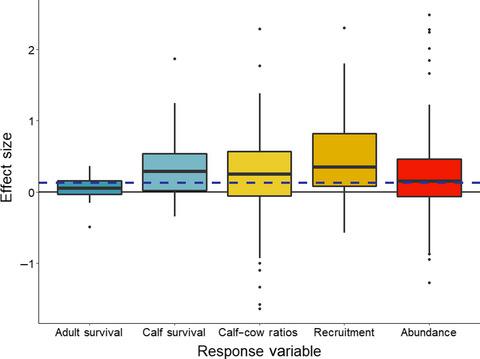当前位置:
X-MOL 学术
›
J. Appl. Ecol.
›
论文详情
Our official English website, www.x-mol.net, welcomes your
feedback! (Note: you will need to create a separate account there.)
Predator control may not increase ungulate populations in the future: A formal meta‐analysis
Journal of Applied Ecology ( IF 5.0 ) Pub Date : 2020-12-07 , DOI: 10.1111/1365-2664.13810 T. J. Clark 1 , Mark Hebblewhite 1
中文翻译:

捕食者的控制将来可能不会增加有蹄类动物的数量:正式的荟萃分析
更新日期:2020-12-07
Journal of Applied Ecology ( IF 5.0 ) Pub Date : 2020-12-07 , DOI: 10.1111/1365-2664.13810 T. J. Clark 1 , Mark Hebblewhite 1
Affiliation

|
- Human‐dominated landscapes are being recolonized by large carnivores, thereby increasing conflicts worldwide via predation of livestock and harvested wildlife such as ungulates. Recent meta‐analyses have shown that predator control (hereafter, predator removal) has mixed success in reducing livestock predation. Yet, it is unknown how effective predator removal is in decreasing predation on ungulates due to a lack of quantitative synthesis, despite the long history of implementation in North America.
- We quantified the demographic responses of ungulate survival and recruitment rates, abundance, and population growth to experimental predator removal and identified the ecological and experimental design factors affecting ungulate responses to predator removal. We conducted a literature review of management and natural experiments to increase ungulate demography finding 52 predator removal experiments and 10 natural experiments from 47 publications. We then conducted a meta‐analysis to determine the overall effect size and factors which increased ungulate demography during predator removal. Lastly, we tested for evidence of publication bias and experimental rigour for these experiments.
- We found that predator removal in both management and natural experiments increased ungulate demographic responses by 13% (95% CI = 4.1%–23%), yet prediction intervals overlapped with 0 (95% PI = −34% to 93%). Focusing just on management removals, ungulate demographic responses increased only by 7.8% (95% PI = −32% to 72%), indicating that future experiments could have negligible effects. Predator removal in both management and natural experiments was more successful in improving the demography of young (e.g. recruitment ES = 44%, 95% CI = 13%–83%) but equivocal in improving adult survival (ES = 5.4%, 95% CI = −18% to 36%) and ungulate abundance (ES = 13%, 95% CI = −17% to 31%). The low and variable effectiveness of predator removal for ungulate populations might be linked to ungulates' slow life history and the compensatory mortality of carnivores on ungulates, though effects were stronger on endangered prey.
- We identified the experimental design factors that led to greater uncertainty in ungulate responses to predator removal, including lack of randomization, low replication and short temporal length. Lastly, we found evidence of publication bias, where experiments with poor rigour and negative effects (i.e. reduced ungulate demography following predator removal) were under‐reported.
- Synthesis and Applications. We recommend future predator removal experiments be conducted with a more rigorous experimental design to overcome these weaknesses, especially for endangered species where predator removal may work more effectively. We suggest that managers attempting to evaluate experimental practices to increase ungulate populations through predator removal could employ an open standards framework akin to the ‘Open Standards for the Practice of Conservation’ framework.
中文翻译:

捕食者的控制将来可能不会增加有蹄类动物的数量:正式的荟萃分析
- 大型食肉动物正在使人类主导的景观重新定殖,从而通过捕食牲畜和收获的野生动物(例如有蹄类动物)而加剧了世界范围内的冲突。最近的荟萃分析表明,控制捕食者(以下称捕食者)在减少牲畜捕食方面取得了不同的成功。然而,尽管在北美实施的历史悠久,但由于缺乏定量综合,尚不清楚如何有效地去除食肉动物以减少有蹄类动物的捕食。
- 我们量化了有蹄类动物的存活和补充率,数量和种群增长对实验性捕食者去除的人口统计学响应,并确定了影响有蹄类动物对捕食者去除的响应的生态和实验设计因素。我们对管理和自然实验进行了文献综述,以增加有蹄类动物的人口统计学,从47个出版物中发现了52个捕食者去除实验和10个自然实验。然后,我们进行了荟萃分析,以确定总体效果大小和在捕食者移除期间增加有蹄类动物人口统计学的因素。最后,我们测试了这些实验的出版偏倚和严格的实验证据。
- 我们发现,在管理和自然实验中,捕食者的去除都使有蹄类动物的人口统计学响应提高了13%(95%CI = 4.1%–23%),但预测间隔与0重叠(95%PI = −34%至93%)。仅关注管理人员的罢免,有蹄类动物的人口统计学响应仅增加了7.8%(95%PI = −32%至72%),表明未来的实验可能产生的影响可忽略不计。在管理和自然实验中,捕食者的清除在改善年轻人的人口统计学方面均较为成功(例如,征募ES = 44%,95%CI = 13%–83%),但在改善成年生存方面却模棱两可(ES = 5.4%,95%CI = -18%至36%)和有蹄类动物的丰度(ES = 13%,95%CI = -17%至31%)。捕食者去除有蹄类动物的效率低下且变化多端,这可能与有蹄类动物的
- 我们确定了实验设计因素,这些因素导致有蹄类动物对食肉动物被移除的反应的不确定性更大,包括缺乏随机性,复制率低和时间长度短。最后,我们发现了发表偏见的证据,其中严谨性和负面影响较弱的实验(即在去除食肉动物后减少有蹄类动物的人口统计学)的报道不足。
- 综合与应用。我们建议以后使用更严格的实验设计进行捕食者清除实验,以克服这些弱点,尤其是对于濒临灭绝的物种,其中捕食者清除可能更有效。我们建议管理人员尝试评估通过去除天敌而增加有蹄类种群的实验方法,可以采用类似于“保护实践的开放标准”框架的开放标准框架。











































 京公网安备 11010802027423号
京公网安备 11010802027423号